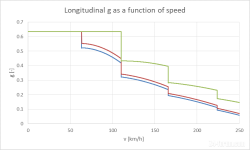just-right
Member
I have been looking at a few performance mods for the M. I have wondered what kind of change could be expected in acceleration time. Considering last week’s bad weather I had some time to write a little program that simulates a Z4M in acceleration all the way up to top speed. I thought some of you might be interested in the results.
In OEM spec the figures are not too far off real life data (). They would be pretty close accounting for shifting:
0 – 100 kph : 4.91s (4.9 – 5.0)
0 – 200 kph : 16.73s (17.0)
400 m : 13.06s (13.2)
1000 m : 23.51s
Vmax : 281.1 kph
Max g : 0.63
First look is at different final drive ratios, comparing the stock 3.62 (Blue) to 3.91 (Red) and 4.1 (Green). A shorter final drive is a bit quicker across the board and helps top speed as well by being closer to max power.
0 – 100 kph : 4.91s -> 4.82s -> 4.81s
0 – 200 kph : 16.73s -> 16.46s -> 16.34s
Vmax : 281.1 kph -> 284.5 -> 285.4 redlining 6th gear
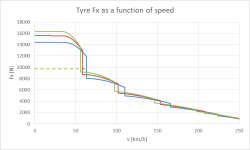
First gear acceleration is similar to stock as you are grip limited (dotted line). Acceleration after that is slightly better for the shorter final drive ratios when you are in the same gear and drops off where the gears are offset (i.e. 3rd gear on 4.1 and 2nd on 3.62 ratio). The time delta and the delta of longitudinal tyre force shows this behaviour and their relationship quite well.
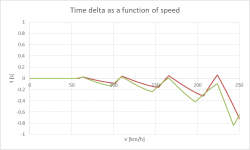
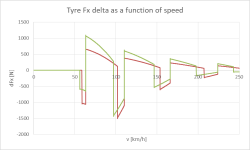
The original gear and final drive ratios would theoretically allow a top speed of over 300 kph. The OEM 6th gear and final drive combination is mainly chosen to keep the cruising RPM and fuel consumption a bit lower. The RPM drop is defined by the gearbox ratios and therefore do not change.
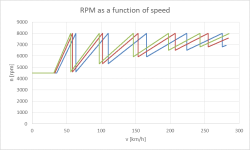
Overall, shortening the final drive looks like a pretty solid step. I will have a look at some other options, like increased power and weight reduction.
In OEM spec the figures are not too far off real life data (). They would be pretty close accounting for shifting:
0 – 100 kph : 4.91s (4.9 – 5.0)
0 – 200 kph : 16.73s (17.0)
400 m : 13.06s (13.2)
1000 m : 23.51s
Vmax : 281.1 kph
Max g : 0.63
First look is at different final drive ratios, comparing the stock 3.62 (Blue) to 3.91 (Red) and 4.1 (Green). A shorter final drive is a bit quicker across the board and helps top speed as well by being closer to max power.
0 – 100 kph : 4.91s -> 4.82s -> 4.81s
0 – 200 kph : 16.73s -> 16.46s -> 16.34s
Vmax : 281.1 kph -> 284.5 -> 285.4 redlining 6th gear

First gear acceleration is similar to stock as you are grip limited (dotted line). Acceleration after that is slightly better for the shorter final drive ratios when you are in the same gear and drops off where the gears are offset (i.e. 3rd gear on 4.1 and 2nd on 3.62 ratio). The time delta and the delta of longitudinal tyre force shows this behaviour and their relationship quite well.


The original gear and final drive ratios would theoretically allow a top speed of over 300 kph. The OEM 6th gear and final drive combination is mainly chosen to keep the cruising RPM and fuel consumption a bit lower. The RPM drop is defined by the gearbox ratios and therefore do not change.

Overall, shortening the final drive looks like a pretty solid step. I will have a look at some other options, like increased power and weight reduction.
